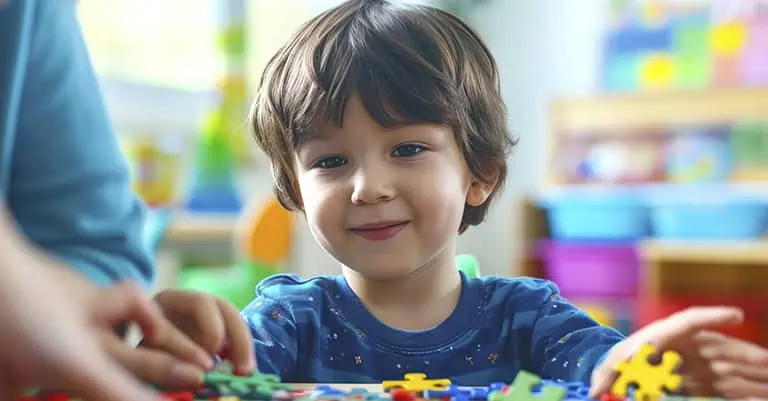Autism Spectrum Disorder (ASD) is a developmental condition that affects how individuals communicate, interact, and experience the world around them. Because symptoms and severity vary widely, the DSM-5 categorizes autism into three levels to help providers determine how much support someone may need in daily life. The levels of autism aren’t static — symptoms can change with time, intervention, and development — but they provide a helpful framework for understanding the spectrum.
Level 1: Mild autism – when support makes a big difference
At Level 1, individuals may not need intensive assistance, but they still experience meaningful challenges with social communication, flexibility, and organization. These individuals often have average or above-average intelligence and may speak fluently, but they can struggle to initiate conversations, understand unspoken social rules, or shift between topics appropriately. Misinterpreting sarcasm, tone, or facial expressions is common.
Behaviorally, Level 1 individuals may prefer strict routines and become distressed when their schedules are disrupted. They might have narrow interests or engage in repetitive behaviors, such as pacing or hand-flapping, but these typically don’t interfere significantly with daily functioning. However, changes in environment or expectations can create considerable anxiety.
Treatment at this level is typically provided on an outpatient basis and may include social skills training, speech-language therapy, behavioral interventions, and occupational therapy. Cognitive-behavioral therapy (CBT) can also be helpful for addressing anxiety and building coping skills. With early and consistent support, many individuals at Level 1 can function independently at school, work, and in the community.
Level 2: Moderate autism – more challenges, more structure
People with Level 2 autism demonstrate more obvious challenges with communication and behavior that can significantly affect daily life. Verbal communication may be limited or idiosyncratic, and some individuals rely heavily on scripting, echolalia (repeating words or phrases), or visual supports to communicate. Conversations may be one-sided or difficult to initiate and sustain, and nonverbal cues such as eye contact, gestures, and facial expressions are often limited or absent.
Social interaction at this level is often restricted to familiar caregivers or structured environments. Individuals may struggle to understand shared interests or emotional reciprocity, making peer relationships difficult to form or maintain. Social anxiety or frustration may escalate quickly, particularly when routines are interrupted or expectations are unclear.
Level 2 individuals typically engage in more frequent and noticeable repetitive behaviors. These may include hand-flapping, rocking, vocalizations, or intense fixation on specific topics. Sensory sensitivities —such as aversion to loud noises, textures, or lights — are also more pronounced and may trigger meltdowns or withdrawal.
Treatment at this level requires a more intensive, structured approach. Most individuals benefit from an interdisciplinary team that includes speech therapists, occupational therapists, behavioral specialists, and physicians. Applied Behavior Analysis (ABA) or other evidence-based behavioral therapies are often central to treatment, with interventions delivered more frequently or in longer sessions than at Level 1. Educational accommodations, caregiver training, and access to mental health support are also critical for success.
Level 3: Severe autism – around-the-clock care needs
Level 3 is the most intensive classification of autism, reserved for individuals who face profound challenges in both communication and behavior. Many individuals with this level of severe autism are nonverbal or use very limited verbal language. They may rely on augmentative and alternative communication (AAC) tools such as picture exchange systems, communication devices, or sign language to express their needs and preferences.
Social interaction is extremely limited. Some individuals may appear unresponsive to others or uninterested in social engagement. Others may want to connect but are unable to do so effectively due to cognitive, sensory, or communication barriers. Even with significant prompting or support, reciprocal communication is often minimal.
Repetitive behaviors and restricted interests are more intense and may interfere with health and safety. These can include persistent self-injurious behaviors (such as head-banging or biting), aggressive outbursts, or complete shutdown in response to overstimulation. Sensory sensitivities are often extreme, and even small changes in environment or routine can lead to overwhelming distress.
Individuals at Level 3 often require 24/7 supervision and hands-on assistance with basic daily tasks such as bathing, dressing, eating, and toileting. Co-occurring conditions — such as intellectual disability, seizure disorders, or psychiatric symptoms — are more common and can complicate care. Because of the complexity of their needs, these individuals typically benefit from highly specialized, structured environments that are equipped to provide medical care alongside behavioral and therapeutic support.
Inpatient support for autism at Nexus
For children, adolescents, and young adults with Level 2 or Level 3 autism — especially those whose needs surpass what can be managed at home or in outpatient settings — the New Directions Program provides a safe, inpatient treatment environment that bridges the gap between behavioral and medical care.
Located in a hospital-based setting, New Directions serves patients with moderate to severe autism, who often have co-occurring conditions such as aggression, self-injury, psychiatric instability, or chronic medical issues. With around-the-clock medical oversight and a highly structured therapeutic program, the team delivers integrated treatment that supports every aspect of a patient’s wellbeing — from communication and sensory needs to safety, function, and long-term planning.
Each patient receives a customized treatment plan developed by an interdisciplinary team, including physicians, psychologists, Board-Certified Behavior Analysts, therapists, and nurses. The program is designed not only to stabilize immediate concerns, but also build skills that support meaningful progress and safe transition back to home, school, or other supportive settings.
To learn more about how Nexus helps individuals with autism achieve lasting outcomes, contact a member of our care coordination team.

